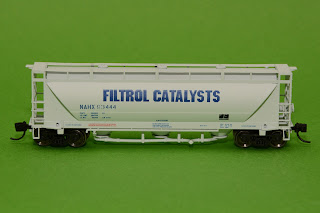This seems not to be the case in the US. Whenever I go there, different items are available in the stores. So it makes little sense to plan the purchase ahead. And I am limited to what is available at the time of my visit.
This time I wanted to buy a locomotive from Atlas, as I had no products from that company, yet. I quickly realized that an Alco S2 model was offered at the moment and I liked the engine a lot. Unfortunately it was sold out at several stores and it took me some time to actually find it. Finally I ordered it from BLW and it set me back $165.70 including shipping.
The model is Atlas 40000721 and is part of the Master Line / Gold Series. That means it is factory equipped with a DCC decoder and a sound unit. It comes in a usual transparent plastic box:
The locomotive is nicely packaged. It is secured in the box with some extra foam (so it does not fall out) and even more foam is used to protect the handrails. It looks as the manufacturer really cared about delivering it unscathed.
Reaching the bottom of the box reveals three pieces of documentation. We get an assembly manual and a warranty certificate. And we also get a DCC quick guide which is unfortunately just a short version of a full document that has to be downloaded from the Atlas website.
Let's take a look at the model. Here it is in its full glory...
As we can see the engine looks very nice and detailed. We get handrails everywhere, a body with a lot of moulded elements and a very, very tiny horn at the top of the cabin. The locomotive is available in several versions, and I've chosen an orange / olive green Great Northern painting. I don't regret my choice at all - it's not only beautiful but also very different from all my other rolling stock.
It's pretty pointless to describe every single aspect of the model's look. Let's see some photos instead.
The handrails are an interesting element on this engine. The ones on the sides are rather stiff but the ones in the front and the back are very flexible. They really bend easily, even at the slightest touch. They do get back to their original position nicely though.
Let's talk about features...
The engine is DCC controlled and it worked with my Roco Z21 central station right away. After assigning the address, I was able to use it immediately. It runs nicely and did not derail (under normal conditions) even once. It has no problem with my Kato turnouts and passes them at any speed in any direction.
The locomotive does not like very tight curves. I do have an R150/R183 section on my test layout and the model would not perform well there. It's not really surprising, however my European models of similar body length do pass this section without much trouble. Consider this in case your layout is really tiny.
DCC aspect of the model surprised me a lot. Looking at my other American engines, I expected to be able to control the speed and to invoke some simple sounds. This is not the case here. The model offers a lot more and it actually gets pretty complex...
We get around a dozen of sounds. Most of them work as usual but some of them have special requirements:
- There are - for example - effects available only when the engine is moving.
- There's an option to manually notch up / down the engine which gives us much more control.
- Last but not least - by default the locomotive will not move forward until the "engine start up" sound finishes playing.
All those DCC functions add a lot of realism and possibilities. I'm glad however that they're not forced on us. It's nice that we can play with a lot of options, but being able to just run our trains (several at once preferably) is very important to me, too.
Here's a demo of my unit. Not all the DCC features are shown. Those that require a running engine are simply too difficult to shoot :)
Looking back at the photos we can see the model does not offer any sort of a speaker grill. This means the speaker is fully inside the body and it raises the question of sound quality. For me the audio is perfectly fine on this engine. It's loud and clear and I could not hear any negative effects of hiding the speaker.
Summary
Well, it's another successful "investment" on my side. After spending some hours with the engine I have to say I like it a lot. This model was slightly more expensive than my previous American units, but I have to admit it also offers many more functions. Those are a little overwhelming at first but fortunately they don't have to be used all at once. So if you can find this locomotive at a price that suits you, it would be difficult not to recommend the purchase.Pros:
- very nice and detailed model
- very secure packaging
- lots of functions for advanced users
- loud and clear sound effects
- runs great
- easy start-up despite complex options
- DCC possibilities may seem overwhelming
- only short DCC guide included
- tight curve performance could be better
- more expensive than other models





















































































